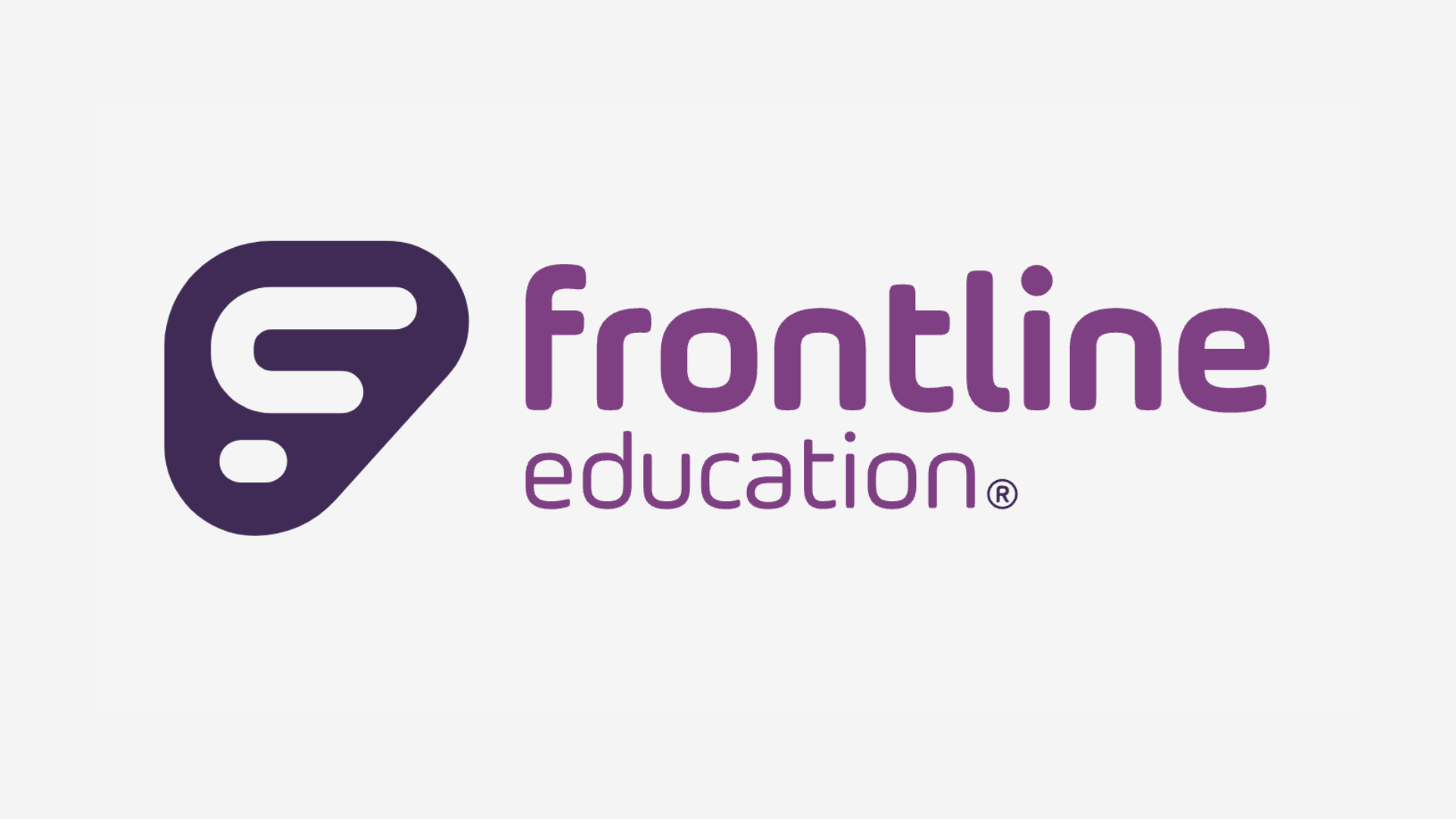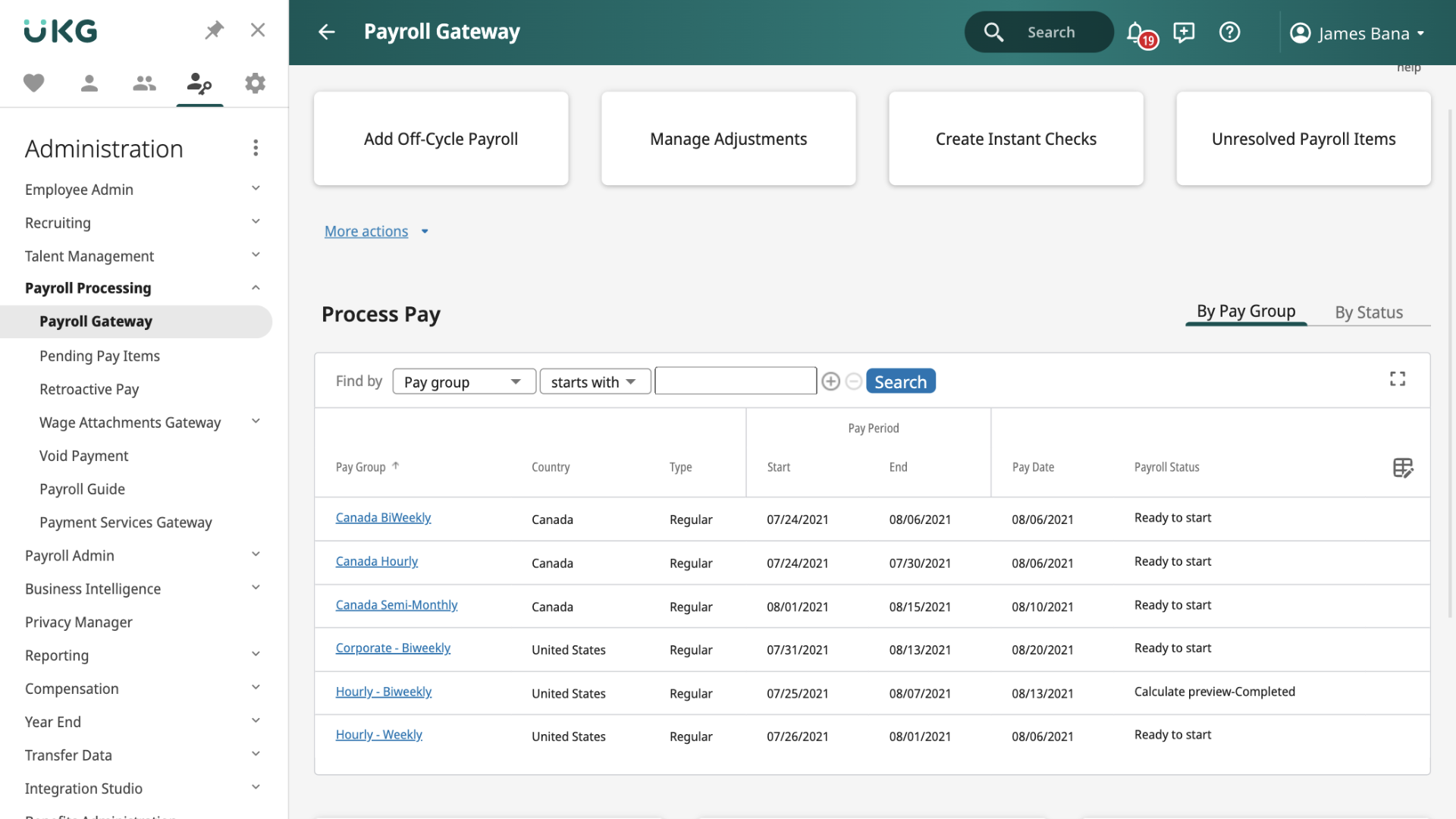The Scrumban methodology guide explores how teams can blend Scrum and Kanban to enhance workflow efficiency, improve flexibility, and optimize project management. It was initially introduced as a transitional framework for teams shifting from Scrum to Kanban, but it has since evolved into a standalone Agile approach that combines the structured planning of Scrum with the adaptability of Kanban.
Teams adopt Scrumban because it removes the rigid sprint structure of Scrum while maintaining Kanban’s continuous flow of work. This hybrid model is ideal for teams that need greater flexibility, want to eliminate bottlenecks, and aim to improve their processes continuously.
With work-in-progress (WIP) limits, just-in-time planning, and pull-based task management, Scrumban helps teams deliver efficiently without the constraints of fixed iterations. By the end of this guide, you’ll understand how it enhances agile project management and whether it’s the right fit for your team’s workflow.
What is Scrumban?
The Scrumban methodology guide introduces a hybrid Agile framework that merges the best elements of Scrum and Kanban to create a more flexible and efficient workflow. Originally designed as a transition method for teams moving from Scrum to Kanban, Scrumban has evolved into a standalone approach that balances structure with adaptability.
Scrumban incorporates Scrum’s planning discipline while leveraging Kanban’s continuous flow and work-in-progress (WIP) limits. This allows teams to prioritize tasks dynamically without being constrained by fixed sprints. Unlike Scrum, where work is planned in time-boxed iterations, it operates with a pull-based system, meaning tasks are worked on as capacity allows rather than being forced into a rigid cycle.
How Does It Differ from Scrum and Kanban?
| Feature | Scrum | Kanban | Scrumban |
|---|---|---|---|
| Workflow | Sprint-based | Continuous flow | Hybrid (flow-based with structured planning) |
| Planning | Sprint backlog | Work-in-progress (WIP) limits | Pull-based, just-in-time planning |
| Roles | Defined roles (Scrum Master, Product Owner, Team) | No fixed roles | Flexible roles |
| Meetings | Daily standups, sprint planning, retrospectives | As needed | Minimal meetings, focus on continuous improvement |
| Best for | Teams needing structured iteration cycles | Teams needing continuous flow | Teams needing flexibility while maintaining structure |
How Scrumban Works- Key Principles
The Scrumban methodology guide emphasizes a flexible, flow-based system that enhances productivity while reducing inefficiencies. Unlike Scrum’s rigid sprint cycles, it enables teams to work at their own pace while maintaining structure and continuous improvement. Below are the key principles that define how Scrumban operates.
Pull-Based Workflow
In traditional Scrum, work is planned in time-boxed sprints, requiring teams to complete a set of tasks within a fixed period. In contrast, Scrumban uses a pull-based system, where tasks are pulled into progress only when the team has capacity. This prevents work overload and ensures a steady, manageable workflow.
- Developers or team members pull the next highest-priority task from the backlog when they have the bandwidth.
- No fixed iterations or sprint planning meetings, allowing for continuous work progression.
- Ideal for teams working on ongoing projects, support tasks, or unpredictable workloads.
By following a pull-based system, teams reduce the risk of unfinished tasks piling up while maintaining productivity.
Work-in-Progress (WIP) Limits
One of Scrumban’s most powerful features is Work-in-Progress (WIP) limits, which help prevent bottlenecks and ensure smooth task flow.
- WIP limits restrict the number of active tasks a team or individual can handle at a time.
- Example: A team may set a WIP limit of three tasks per developer to prevent overload and enhance focus.
- Once a team member completes a task, they can pull the next item from the backlog.
This approach prevents teams from juggling too many tasks at once, ensuring a consistent and efficient workflow.
Just-in-Time Planning
Unlike Scrum, where teams plan tasks at the start of each sprint, Scrumban only plans when necessary.
- Instead of planning every two weeks, teams trigger planning sessions when the backlog reaches a predefined threshold.
- This encourages adaptive planning, meaning teams can adjust priorities based on new requirements.
- Helps teams remain responsive to real-time changes rather than being locked into predefined sprint goals.
Just-in-time planning eliminates unnecessary backlog grooming and ensures that teams only plan work when needed.
Continuous Improvement (Kaizen)
Scrumban focuses on continuous improvement by measuring and optimizing team performance using agile methodologies.
- Teams track cycle time, lead time, and throughput to analyze performance and identify inefficiencies.
- Instead of fixed Sprint Reviews, teams hold ongoing retrospectives to refine processes and eliminate waste.
- Encourages Kaizen (continuous improvement), helping teams enhance workflow over time.
By analyzing real-time performance data, teams can make informed decisions and streamline their processes without being tied to rigid frameworks.
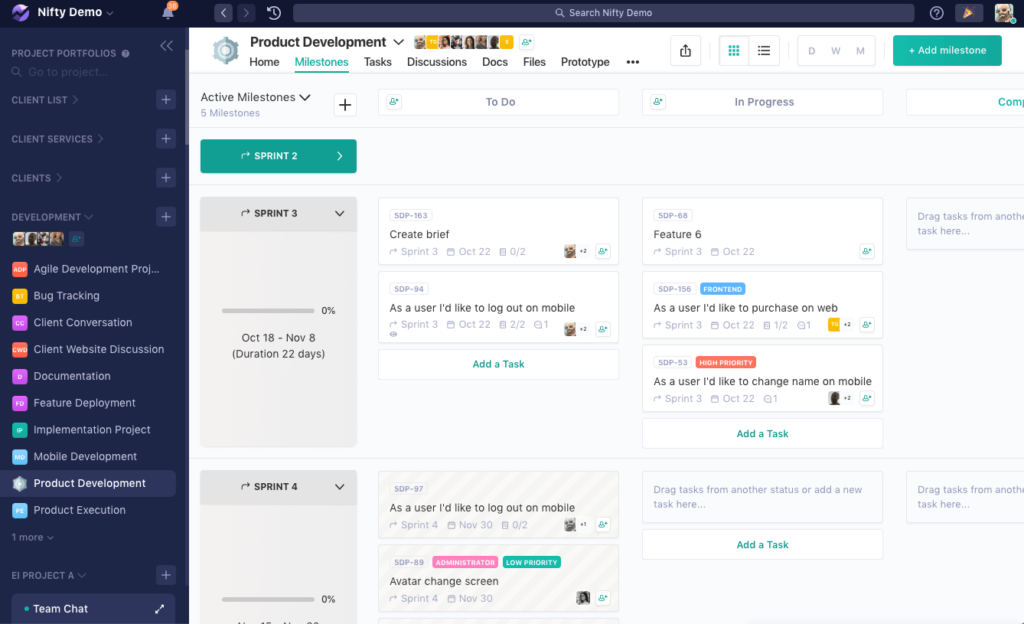
How These Principles Benefit Teams
| Principle | Key Benefit |
|---|---|
| Pull-Based Workflow | Prevents overload and enables a steady task flow. |
| Work-in-Progress (WIP) Limits | Ensures efficiency by controlling the number of active tasks. |
| Just-in-Time Planning | Reduces unnecessary meetings and backlog grooming. |
| Continuous Improvement (Kaizen) | Uses real-time data to optimize team performance. |
The Scrumban methodology guide provides a structured yet flexible approach to agile work management. Teams using it reduce inefficiencies, improve adaptability, and maintain consistent delivery—all without the constraints of traditional sprint cycles.
Benefits of Scrumban
The Scrumban methodology guide highlights how this hybrid framework balances structure and flexibility, making it ideal for teams that need a dynamic workflow without the constraints of traditional Scrum. By combining Kanban’s continuous flow with Scrum’s structured planning, Scrumban helps teams work more efficiently and adapt quickly to changing priorities.
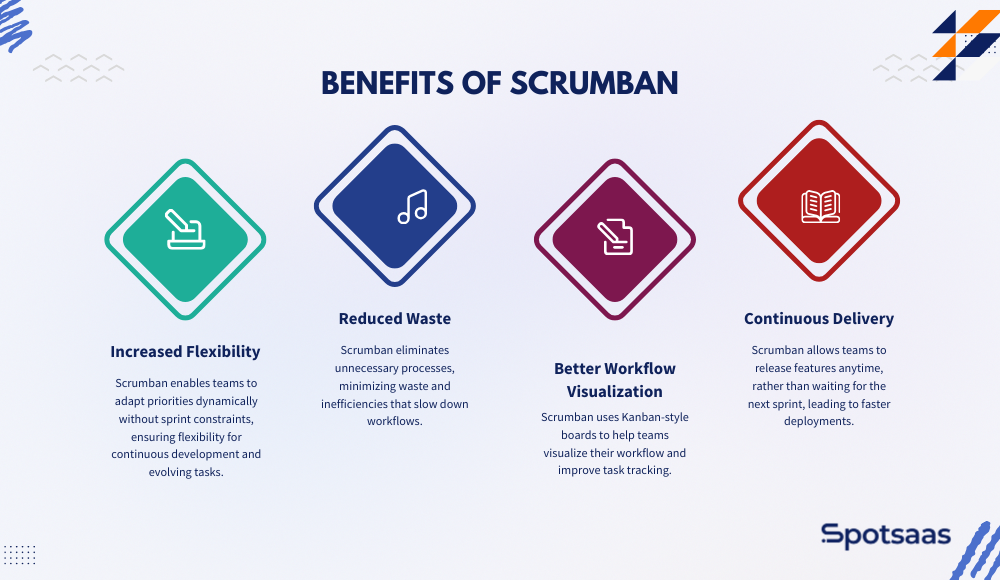
Increased Flexibility
Unlike Scrum, which requires fixed-length sprints, Scrumban allows teams to adjust priorities dynamically.
How It Helps Teams
Teams are not confined to sprint cycles, allowing them to respond to new requirements in real time. Tasks are pulled into progress only when capacity allows, avoiding unnecessary task assignments. This approach is ideal for teams handling continuous development, maintenance work, or unpredictable workloads.
With greater adaptability, teams can shift focus when priorities change without waiting for a sprint to end.
Reduced Waste
Scrumban eliminates unnecessary processes, minimizing waste and inefficiencies that slow down workflows.
How It Helps Teams
It reduces excessive sprint planning, backlog grooming, and daily meetings. Just-in-Time (JIT) planning ensures teams only plan when backlog tasks reach a threshold. This approach prevents overloading sprint backlogs with unprioritized tasks.
By cutting down on non-essential activities, teams can focus on delivering value rather than spending time in meetings.
Better Workflow Visualization
Scrumban uses Kanban-style boards to help teams visualize their workflow and improve task tracking.
How It Helps Teams
Clear task visualization allows teams to see work-in-progress, bottlenecks, and completed tasks in real-time. Work-in-Progress (WIP) limits ensure tasks move forward efficiently without overwhelming the team. Data-driven decision-making, using cycle time and throughput metrics, helps optimize work processes.
By making tasks visible and easy to track, teams improve efficiency and collaboration.
Continuous Delivery
Scrumban allows teams to release features anytime, rather than waiting for the next sprint, leading to faster deployments.
How It Helps Teams
No fixed sprint deadlines mean that teams can push updates whenever a task is completed. Incremental delivery allows teams to ship small, frequent improvements rather than waiting for a large release. This approach is perfect for product teams, DevOps, and continuous integration (CI/CD) environments.
This streamlined approach ensures that customers receive updates and improvements faster, enhancing user satisfaction.
How Scrumban Enhances Productivity
| Benefit | How It Helps Teams |
|---|---|
| Increased Flexibility | Allows dynamic priority changes without waiting for sprints to end. |
| Reduced Waste | Eliminates unnecessary planning and backlog grooming. |
| Better Workflow Visualization | Improves tracking of tasks and work-in-progress. |
| Continuous Delivery | Enables faster and more frequent product releases. |
The Scrumban methodology guide showcases how this framework boosts efficiency, simplifies workflows, and accelerates delivery cycles. Whether a team is transitioning from Scrum, looking for a more adaptive approach, or handling continuous work, it provides an optimized way to manage tasks effectively.
When Should You Use Scrumban?
The Scrumban methodology guide provides a hybrid approach that blends Scrum’s structured planning with Kanban’s flexibility. While some teams prefer pure Scrum or Kanban, it is the ideal solution for those who require a balance between both methodologies.
Understanding when to use Scrumban can help teams improve workflow efficiency, reduce bottlenecks, and enhance adaptability.
Teams Transitioning from Scrum to Kanban
Teams accustomed to Scrum’s time-boxed sprints can adopt Scrumban to introduce a more flexible, flow-based system without immediately discarding all Scrum elements. Work-in-Progress (WIP) limits help manage workloads while maintaining structure. Just-in-Time (JIT) planning reduces unnecessary sprint planning sessions, allowing teams to focus on real-time priorities.
Projects Requiring Continuous Flow of Work
Certain projects demand a continuous flow of tasks rather than sprint-based execution. For teams working on long-term, evolving projects, Scrumban provides the flexibility to pull tasks as needed rather than being constrained by fixed-length sprints.
It eliminates the risk of carrying unfinished work into the next sprint and ensures that work progresses at an optimal pace without arbitrary deadlines.
Maintenance and Support Teams Handling Unpredictable Requests
Scrumban is particularly useful for teams responsible for handling ongoing maintenance, bug fixes, and customer support tasks. Unlike Scrum, which requires planning work ahead of time, Scrumban enables teams to manage unpredictable incoming requests efficiently.
Teams can prioritize urgent issues without disrupting the workflow. WIP limits ensure that tasks are handled at a sustainable pace without overwhelming the team.
Agile Teams Struggling with Scrum’s Rigid Iterations but Still Needing Structure
Some teams find Scrum’s rigid sprint cycles too restrictive but still require some level of process organization. Scrumban allows teams to retain elements of Scrum, such as backlog management and retrospectives, while benefiting from Kanban’s continuous delivery model.
Teams can adapt workflows as needed, rather than being locked into a predefined sprint structure. Planning happens on-demand rather than at the start of each sprint, giving teams more control over how and when they execute tasks.
Implementing Scrumban: Step-by-Step Guide
The Scrumban methodology guide provides a structured yet flexible approach to agile project management. By following a step-by-step implementation, teams can optimize workflows, balance workloads, and continuously improve efficiency.
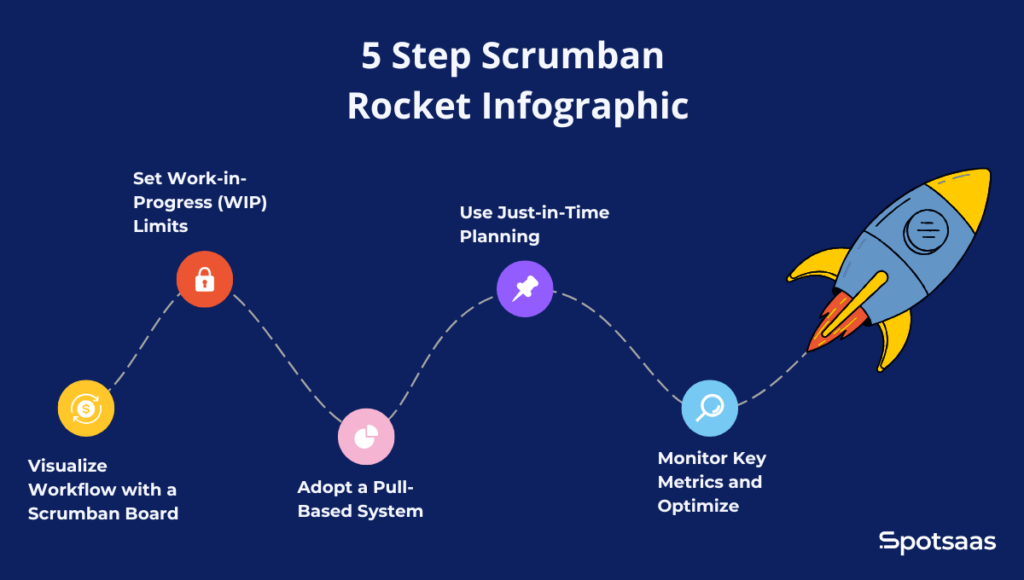
Step 1: Visualize Workflow with a Scrumban Board
A Scrumban board serves as a central tool for tracking tasks and maintaining workflow visibility. Teams should create a Kanban-style board with columns such as To-Do, In Progress, Testing, and Done to categorize tasks based on their current status.
Depending on workflow complexity, additional columns like Review, Blocked, or Ready for Deployment can be added. A well-structured board provides real-time visibility into task progress, helping teams identify and resolve bottlenecks quickly.
Step 2: Set Work-in-Progress (WIP) Limits
To maintain an efficient workflow and prevent multitasking overload, Scrumban introduces Work-in-Progress (WIP) limits. These limits define the maximum number of tasks that can be in progress at any given time.
For instance, a development team may set a WIP limit of three tasks per developer, ensuring that no one is overburdened and that work moves forward at a steady pace. This approach prevents unfinished work from piling up, helping teams stay focused, reduce stress, and improve task completion rates.
Step 3: Adopt a Pull-Based System
Unlike Scrum’s predefined sprint cycles, Scrumban follows a pull-based system where tasks move forward based on team capacity. Instead of assigning tasks in advance, team members pull work from the backlog only when they are ready to take on new work.
This eliminates unnecessary pressure from fixed sprint deadlines and allows teams to maintain a steady workflow without excessive planning overhead. A pull-based approach promotes a self-managed work environment, where teams prioritize high-value tasks based on real-time needs rather than predefined iterations.
Step 4: Use Just-in-Time Planning
Scrumban replaces traditional sprint-based planning with Just-in-Time (JIT) planning, allowing teams to plan work only when necessary. Instead of scheduling work at the start of each sprint, planning is triggered when the backlog reaches a predefined threshold.
This method reduces unnecessary meetings and ensures that teams focus on only the most relevant and high-priority tasks. By implementing JIT planning, teams can adapt to changing requirements quickly, avoiding the rigidity of time-boxed sprint planning while maintaining structured workflows.
Step 5: Monitor Key Metrics and Optimize
To ensure continuous improvement, Scrumban teams should track key performance metrics that help identify inefficiencies and optimize workflow processes. Important metrics include Cycle Time, which measures how long a task takes to move from “To-Do” to “Done,” Lead Time, which tracks the total duration from task creation to completion, and Throughput, which evaluates the number of tasks completed within a specific timeframe.
Common Challenges and How to Overcome Them
The Scrumban methodology guide provides an effective balance between Scrum and Kanban, but teams transitioning to it may encounter challenges in adapting to its flexible workflow. Here are the most common challenges of implementing Scrumban and the best strategies to overcome them effectively.
Lack of Defined Roles
One of the biggest adjustments for teams moving from Scrum to Scrumban is the absence of predefined roles such as Scrum Master and Product Owner. In Scrum, each role has distinct responsibilities, but Scrumban allows for a more flexible, role-free structure, which can sometimes create confusion regarding accountability.
Resistance to Change
Teams that have been using Scrum for an extended period may resist adopting Scrumban, as it requires a shift from sprint-based work cycles to a more flexible pull-based system. Some team members may feel uncertain about how work will be structured without sprints, and leadership may be hesitant about moving away from traditional planning methods.
Difficulty in Measuring Success
Since Scrumban does not rely on time-boxed sprints, it can be challenging for teams to measure success and track progress without the usual sprint goals and velocity calculations. Without proper tracking, leadership may struggle to assess team efficiency and overall project performance.
How Overcoming These Challenges Improves Scrumban Adoption
| Challenge | Solution |
|---|---|
| Lack of Defined Roles | Assign responsibilities based on expertise rather than predefined roles. |
| Resistance to Change | Implement Scrumban gradually and offer team training. |
| Difficulty in Measuring Success | Use Kanban metrics like cycle time, lead time, and throughput to track performance. |
Transitioning to Scrumban requires a shift in mindset, but by addressing these common challenges, teams can successfully implement this hybrid approach and improve their workflow efficiency. This helps teams navigate these changes while maximizing the benefits of flexibility, adaptability, and continuous improvement.
Tools for Managing Scrumban Workflows
| Tool | Features | Best For |
|---|---|---|
| Jira | Kanban boards, backlog management | Software development teams |
| Trello | Drag-and-drop workflow, task tracking | Small teams & startups |
| Monday.com | Visual project tracking, automation | Agile teams in any industry |
| Asana | Task dependencies, collaboration tools | Cross-functional teams |
Conclusion
The Scrumban methodology guide demonstrates how this hybrid framework successfully blends Scrum’s structured planning with Kanban’s flexibility, creating an adaptive approach to agile project management. By allowing teams to work at their own pace while maintaining structured workflows, Scrumban provides an efficient, scalable, and practical solution for teams managing continuous tasks, transitioning from Scrum, or handling unpredictable workloads.
Implementing Work-in-Progress (WIP) limits, a pull-based task system, and Just-in-Time planning helps teams optimize efficiency, minimize bottlenecks, and improve overall productivity. Additionally, leveraging the right workflow visualization tools and tracking key performance metrics like cycle time, lead time, and throughput ensures continuous improvement and data-driven decision-making.
For teams looking to embrace agility without sacrificing structure, Scrumban offers the best of both worlds. By adopting its principles, teams can enhance collaboration, streamline workflows, and maintain long-term project efficiency, making it an excellent choice for evolving agile environments.
Frequently Asked Questions
What is Scrumban, and how does it differ from Scrum and Kanban?
Scrumban blends Scrum’s structured planning with Kanban’s flexible workflow, eliminating fixed sprints and using a pull-based system.
When should a team use Scrumban?
Scrumban is ideal for teams transitioning from Scrum to Kanban, handling continuous workflows, or managing unpredictable tasks.
How does Scrumban improve workflow efficiency?
It optimizes work using Work-in-Progress (WIP) limits, Just-in-Time planning, and Kanban visualization to enhance task management.
How do you measure success in Scrumban without sprints?
Teams track Cycle Time, Lead Time, and Throughput to measure efficiency instead of relying on sprint-based progress.
What tools are best for managing Scrumban workflows?
Tools like Jira, Trello, Monday.com, and Asana help teams manage Scrumban boards, workflows, and task tracking.



